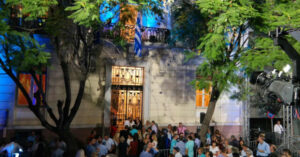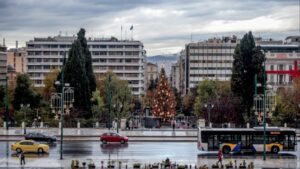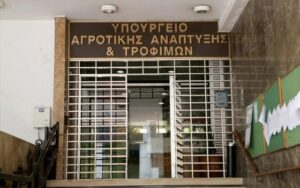The New Democracy is returning – even if only for a short while – to its historic headquarters on Rigillis Street, on the occasion of the celebration of 50 years since its founding.
The party’s president and prime minister, Kyriakos Mitsotakis, will address a speech on Friday, October 4, at 20:00, at a special event to be held outside the party’s historic offices. The event is particularly symbolic, as the return to the headquarters on Rigillis Street highlights the course of New Democracy from its foundation to the present day.
The symbol of the history of the Republic of Greece from its origins to the present day.
The message “Let’s head to Rigillis”, as captured in the video posted by the party on social media, marks the return to a place full of memories and emotional value for the friends and members of New Democracy.
Watch the video:
50 years of New Democracy.
On Friday, October 4, we celebrate the 50th anniversary of the founding of our party. At 20:00 we will all be at the Rigillis! pic.twitter.com/oCPr2TMFv0
– NEW DEMOCRACY (@neademokratia) October 1, 2024
Preparations are in full swing for the highly anticipated Rigillis street party, where blue supporters will gather to commemorate a significant anniversary. An anniversary video is set to be showcased before the Prime Minister’s speech, with mobilization efforts ramping up to ensure a strong turnout from party members across all generations.
To elevate the festive atmosphere, a DJ will spin songs.
In the summer of 2019, Margi S.A., a luxury hotel in Vouliagmeni owned by Maria Stavridis and her sons Giangos and Thodoris Agiostratitis wanted to create a luxury boutique hotel in one of the most emblematic spots of the capital.
Negotiations with the Foundation were completed in July 2019 and a month later the Decentralized Administration of Attica gave its approval for the reconstruction and operation of the property, with the procedure of a long-term lease for 50 years, with the following conditions:
■ Investment for repairs amounting to 1.68 million euros including VAT.
■ Monthly rent of €16,000 plus stamp duty for the first five years and thereafter with annual adjustment based on the Consumer Price Index, plus 1% of the rent. Thereafter, interested parties will be required to submit a 50-year offer table for the rent indexation with a 5-year differentiation, taking into account the rental value of the property after renovation and negotiating the rent after 20 years.
In addition, a security deposit of at least €30,000 and an advance payment of six rents were provided for. As for the completion time of the project, it was set at 18 months. In essence, the owners of the famous “The Margi” saw an opportunity for their rise from the Athenian Riviera to the center of the capital, which now acts as a magnet for the creation of new hotels due to the increasing tourist flow. Of course, the amount of investment would go far beyond that as their vision was, in addition to the general renovation, to make the necessary modifications so that the “blue building” to evolve into one of the most distinctive luxury hotels, due to both its uniqueness and its location in one of the most prestigious areas of the capital and a stone’s throw from the Old Palace and the Megaron Maximou.
A neighborhood where famous names of old money, art, and of course politics lived and still live. Thus, only functional interventions would be made to the main building without changing its architectural structure and style, which, in any case, refers to the layout of French and English hôtels privés, with marble and wooden staircases, large reception areas, spacious and high-ceilinged rooms and, of course, the well-known, from the political backstage, garden.
In addition, it was planned to construct a five-story addition to an existing metal building in the surrounding area of the property. It is noted that the building is located on a plot of 1,017 sqm, with a semi-basement of 190 sqm, ground floor of 175 sqm, first floor of 200 sq.m. and second floor of 210 sq.m. At the back of the plot, later buildings (offices) with a total area of 377.37 sq.m.


In July 2020, the Ministry of Culture issued a ministerial decision designating the property as a newer monument “without the subsequent interventions (addition of buildings in the courtyard, modern partitions, etc.), because it has remarkable architectural and morphological characteristics and is a document for the study of the development of the city of Athens at the beginning of the 20th century from an architectural, historical and social point of view and is inextricably linked to the modern political history of the country, making it a landmark of the city of Athens”.
In addition, it is a product of a branded architecture created by Anastasios Metaxas, and “is located in the wider environment of the archaeological site of the Lyceum of Aristotle”. Following this, as stated, “any intervention on the above monument (repair, maintenance, addition) or any building activity near it is prohibited without first seeking the approval of the Ministry of Culture and Sports through its competent services.”
Approval for the plan to convert it into a boutique hotel and was requested and given by the relevant departments of the Ministry of Culture and Tourism in June 2022. In the decision to approve the design and for the five-story addition, it was emphasized that “the protected newer monument is restored and its use is gentle and respects its typology and morphological structure, and the addition, due to the location of the central configuration of the façade, does not compete with and does not harm the monument aesthetically and visually.”
A few months later, in October 2022, a petition for annulment of the decision was filed before the Fifth Chamber of the Council of State by residents, who were disturbed by the prospect of developing the property, which had been deserted for years.
Watch the video, highlights from the 2015 rally and campaign speech:
To avoid becoming embroiled in a never-ending legal battle that would render the property unusable for several more years (and a lost five-year lease has already expired), the leasing company opted to change course by proceeding with a new rehabilitation study to change its use to residential and without the five-story addition in height.
A new proposal was submitted to the competent services of the Ministry of Culture and Sports in early 2024 by Sophocles Morphopoulos, who through the distinguished architectural firm “Future Constructions” (of Stathis Stathakis and Sophocles Morphopoulos) is involved in the whole project.
On April 4, the decision of the General Director of Restoration, Museums and Technical Works and the General Director of Antiquities and Cultural Heritage was issued by the Ministry of Culture, approving:
■■ The new study for the restoration of the building and its change of use to a residence with the restoration of the existing ground floor in the surrounding area of the monument and the change of use as an attendant, the construction of a swimming pool in its surrounding area and the landscaping of its surroundings.
■ The conservation study of the painted decoration and its decorative elements.
Thus paving the way for the second life of the property at Rigillis 18 as a neoclassical villa with a swimming pool, with the most likely possibility of its inclusion in the portfolio of individual residences of “The Margi” which are leased to its clients. It is noted that the company already operates three tourist villas in Vari, Vouliagmeni, and Agios Sostis of Mykonos. As to when the project will be completed, no one can give a definite answer. This is because there are so many bureaucratic details and hidden obstacles that it is impossible to have a definitive timetable.
Approval by the Ministry of Culture has been secured, but several permits still follow. Suffice it to say that the approval decision includes detailed conditions such as “the proposed works and change of use shall be under the planning, building and other regulations in force in the area and permits from other authorities”, ranging from the submission of a specific frame panel for the restoration on the facades of the building to a written justification for any posting of plaster parts. In fact, the instructions go so far as to stress that “the acrylic-based insulation material of the Remmers Funcosil AG indicator type should not be used to protect the surface of the concrete tiles, but that the application of a hydrophobic material based on siloxanes of the Nanophos indicator type SurfaPore C should be investigated.”
All excavation work “will be carried out under the direct and continuous supervision of a representative of the Antiquities of the City of Athens (EFAPA) and by the guidelines of the Service as to the means to be used (mechanical or manual, where required)”, while in case of detection of antiquities, “the works will be interrupted and a salvage excavation will follow, on the results of which the further course of the project will depend”. Indeed, it is stressed that “the salvage excavation survey that may arise will be carried out by the order of priority of the plots to be excavated observed by our Service”.

Residence Diomedes
The neoclassical building of Rigillis was designed by the architect Anastasios Metaxas, one of the most important architects of his time, who left his mark through the Eugenides and Serpieri houses, as well as the Benaki and Stathatou Mansions on Vassilissis Sofias Avenue, while the Panathenaic Stadium, the present Presidential Palace, etc. were remodeled according to his designs. Metaxas, who was also an expert marksman and twice an Olympic champion in the sport, built the building of the Rigillis for Alexandros Diomedes, who served as Prime Minister in 1949-1950, but also as Governor of the Bank of Greece.
After his death, the property passed, in 1955, through a bequest to the “Botanical Garden of Ioulia and Alexandros N. Diomedes” Foundation. In the early 1960s, it was leased by the Royal Gendarmerie and even “played a leading role” in the 1961 elections, which were described as “elections of violence and fraud”, since, according to the “Black Book” of the Centre Union, published in 1962, 218 voter’s books of gendarmes with a residence address of “18 Rigillis Street, number 18” had been illegally issued, with which they voted more than once. During the junta and for about two years the property housed the Embassy of Egypt, and with the advent of the post-independence era, its next day was the headquarters of New Democracy.
The selection and the relevant recommendation to Constantine Karamanlis were made by Timoleontas Louis, a political eupatriot who played an important role in shaping the ideological framework of the New Democracy. and from 1974 he had taken over the general direction of the party honorarily, from which he resigned in 1976, to found the Centre for Political Research and Training (CPRT). The building’s heavy historical past did not prevent Karamanlis from accepting Louis’ suggestion, and so in July 1975, it was inaugurated as the headquarters of the New Democracy Party.
Since then and for the next four decades, the building became a silent witness to much of the country’s post-independence history, but also the place where the heart of the center-right party beat. A classic case of the application of the witticism about walls that, if they had a mouth, would say a lot…
Crucial decisions were taken in his offices and meeting rooms, while it was in the famous “Garden Room”, known to the initiated as the “Viet Cong cage” because of its shoddy construction that did not protect either the summer from the heat or the winter from the cold and rain, that most of the intra-party contests for the party presidency were held. In this hall, on 9 December 1981, shortly after the crushing defeat of the New Democracy party under Georgios Rallis by PASOK, Evangelos Averoff took over the leadership with 67 votes, prevailing over Kostis Stephanopoulos who got 32, and Ioannis Boutos with 12 votes. There, on 1 September 1984, Konstantinos Mitsotakis took over the presidency, garnering 70 votes to Kostis Stephanopoulos’ 40.
The subsequent contests for the leadership of the party also took place in the “Garden Hall”. In 1993 between Miliadis Evert and Ioannis Varvitsiotis, with the former winning by 141 votes to the latter’s 37. After his election, Evert even renamed the “Garden Hall” to “Konstantinos Mitsotakis Hall”
In 1996, the next brawl between Evert and George Souflias took place there, with the former again winning with 103 votes to the latter’s 84. Furthermore, some of the most crucial meetings took place in the building of the Rigillis, such as when in the mid-1980s the then President Konstantinos Mitsotakis was informed that PASOK would support Christos Sarzetakis for President of the Republic and not Konstantinos Karamanlis. Later, in March 2003, after the US invasion of Iraq, when Kostas Karamanlis met with top officials to analyze the situation.
The building was also associated with the world of New Democracy, as its supporters gathered in the exterior during the great moments of the post-independence period. Moments sometimes with a bitter and sometimes with a sweet taste. It was there that the party’s supporters celebrated on the night of the 2000 elections, carried away by the results of the exit polls, only to be disillusioned a few hours later when PASOK won by a few thousand votes. And there again in 2004 they celebrated, correctly this time, their party’s return to power, with Kosta Karamanlis and his wife Natasha waving to them from the balcony.
For party officials, this space evokes memories, from the “27 steps” to the (then) president’s office to the always “dotted” press office on the floor, and even the small kitchen of Mr. Giannis the Coffee Man. After the transfer of the headquarters, under the presidency of Antonis Samaras, to Sygrou, there was a last glimpse during the 2015 elections with thoughts of returning to the historic cradle of the Rigillis. However, something that was impossible because of the excessive costs of the building on the one hand, and the needs of the party, which needed modern infrastructure on the other. Somehow, the iconic property remained silent and surrendered to the ravages of time.
Ask me anything
Explore related questions





